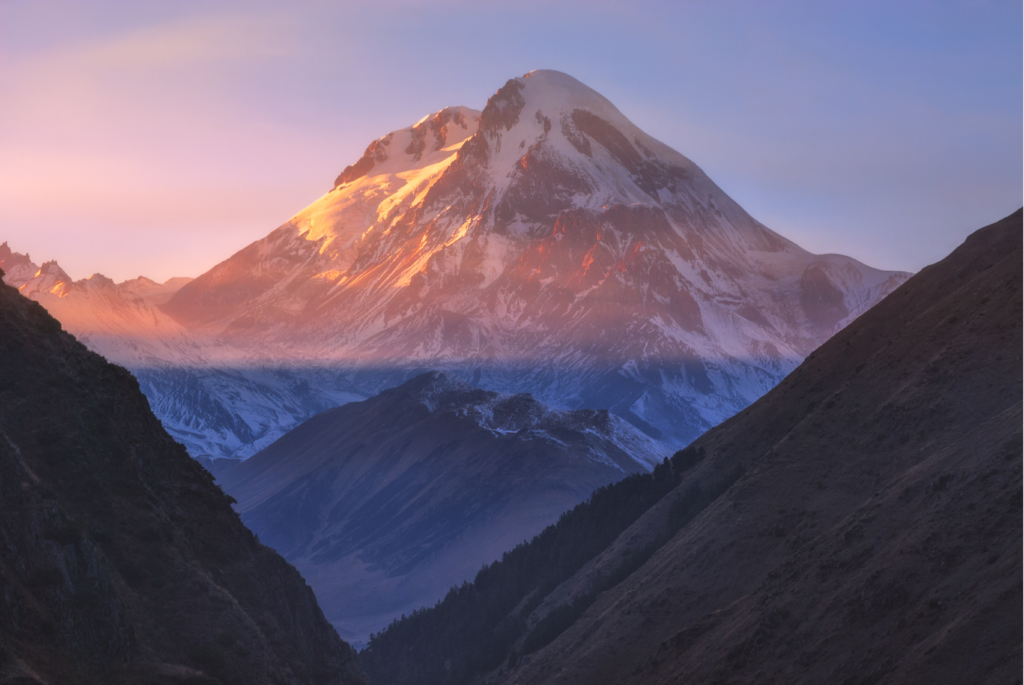Introduction
Nestled in the heart of the Caucasus Mountains, Mount Kazbegi (Kazbek) stands tall at 5,033 meters (16,512 feet), an alluring challenge for mountaineers and adventurers from around the globe. This dormant stratovolcano, known in Georgian as Mkinvartsveri (meaning “Ice Peak”), is not only one of Georgia’s highest peaks but also a place of deep cultural and mythological significance. From its snow-capped summit to the breathtaking valleys below, an expedition to Mount Kazbegi promises both physical exhilaration and an immersion into Georgia’s rugged natural beauty.
In this blog post, we’ll walk you through everything you need to know for a successful climb to the top of this iconic mountain.
Why Climb Mount Kazbegi?
Mount Kazbegi is an ideal target for mountaineers looking to experience the pristine wilderness of the Caucasus. It’s often considered a more approachable climb compared to other 5,000-meter peaks, making it perfect for both seasoned climbers and adventurous beginners with proper training.
But this mountain offers more than a physical challenge. As you ascend, you’ll traverse landscapes steeped in legend. According to Georgian myth, the mountain was where Prometheus was chained as punishment for stealing fire from the gods. Beyond its folklore, the surrounding area is a treasure trove of natural beauty and history—from the ancient Gergeti Trinity Church perched high above the town of Stepantsminda, to the dramatic glaciers that line your path to the summit.
Best Time to Climb
The ideal climbing season for Mount Kazbegi typically runs from June to September. During these months, the weather is more stable, and the snowpack is easier to manage. However, don’t let summer fool you—Kazbegi’s high-altitude terrain can still be unpredictable, with strong winds and sudden snowstorms, so proper preparation is essential.
Winter climbs are possible, but they are only recommended for highly experienced mountaineers equipped to deal with sub-zero temperatures and extreme alpine conditions.
How to Prepare for Your Climb
1. Fitness and Experience
Though considered an easier 5,000-meter peak, climbing Kazbegi still demands a good level of fitness and experience in high-altitude trekking and mountaineering. Previous experience with ice climbing, rope handling, and glacier travel is recommended, as you’ll encounter steep, icy sections, especially near the summit.
It’s also important to acclimatize properly due to the altitude. Plan to spend a few days at base camp or exploring the surrounding area to avoid altitude sickness.
2. Gear Checklist
Here’s a basic gear checklist for your Kazbegi expedition:
- Mountaineering boots (suitable for snow and ice)
- Crampons and ice axe
- Helmet
- Rope and harness
- Insulated clothing and outer layers for extreme cold
- Sleeping bag rated for -15°C or lower
- Sunglasses, sunscreen, and lip balm (the sun is intense at high altitudes)
- Headlamp with extra batteries
- Navigation tools (map, compass, GPS)
Most of the gear can be rented in Stepantsminda, the gateway town to Mount Kazbegi, but if you’re an experienced climber, it’s advisable to bring your own equipment.
Route to the Summit
Day 1: Stepantsminda to Bethlemi Hut
The journey begins in Stepantsminda, a picturesque town located at the foot of the mountain. From here, climbers head to the famous Gergeti Trinity Church (2,170 meters), either on foot or via 4×4 vehicle. The church offers breathtaking views of the surrounding peaks and valleys, a perfect spot to reflect before beginning the ascent.
From the church, the path leads through rolling hills and alpine meadows until you reach the Gergeti Glacier. Crossing the glacier can be challenging due to its crevasses, so it’s essential to use proper safety techniques. After about 6-7 hours of trekking, you’ll arrive at Bethlemi Hut (3,653 meters), the main base camp for climbers attempting the summit. The hut offers simple accommodations and serves as a staging area for final preparations.
Day 2: Acclimatization Day
To properly acclimatize, most climbers spend an extra day at Bethlemi Hut. You can explore nearby ridges or practice glacier travel to prepare for the summit push.
Day 3: Summit Push
Summit day begins early, usually around 2 or 3 a.m. With headlamps lighting your way, the ascent starts across the glacier towards Plateau (4,500 meters). The climb becomes steeper and more technical from here, with several icy slopes that require the use of crampons and ice axes.
The final approach to the summit is both mentally and physically challenging, as you’ll face high winds and steep gradients. However, the reward of reaching the summit is incomparable—the panoramic views of the Caucasus Range and neighboring peaks, stretching all the way to Russia, make every step worth it.
Tips for a Successful Climb
- Hire a Local Guide
While the route is non-technical in parts, hiring a certified mountain guide is highly recommended, especially if it’s your first time on Kazbegi. Local guides are familiar with the mountain’s terrain and unpredictable weather conditions, ensuring a safer and more enjoyable experience. - Take Your Time
Acclimatization is key. Avoid rushing your ascent; spend extra time at higher altitudes to allow your body to adjust. Pacing yourself will also make the climb more enjoyable. - Check the Weather
Kazbegi’s weather can change rapidly. Always check the forecast before attempting your summit push, and be prepared to delay your climb if conditions deteriorate. - Stay Hydrated and Nourished
At high altitudes, dehydration and lack of energy can become serious issues. Carry enough water, and eat energy-rich snacks throughout your climb to maintain strength.
After the Climb: Exploring the Kazbegi Region
Once you’ve successfully summited Mount Kazbegi, the surrounding region offers plenty to explore. Consider visiting the Darial Gorge, one of the most stunning canyons in the Caucasus, or relaxing in one of the local hot springs to soothe your tired muscles. For those interested in history, the Ananuri Fortress and Alaverdi Monastery are must-see landmarks that reflect Georgia’s deep cultural heritage.
Conclusion
Climbing Mount Kazbegi is more than just a physical challenge—it’s a journey through Georgia’s breathtaking natural landscapes, a dive into its rich cultural history, and an opportunity to conquer one of the most iconic peaks in the Caucasus. Whether you’re an experienced mountaineer or a passionate adventurer looking to test your limits, summiting Kazbegi will be an unforgettable experience.
Are you ready to take on the challenge? Pack your gear, gather your courage, and start planning your expedition to Mount Kazbegi today!
Author’s Note:
Whether you’re climbing Mount Kazbegi for the thrill, the views, or the spiritual journey, it’s an adventure like no other. If you’re inspired to conquer Mount Kazbegi and would like help organizing a trip, contact us and we’ll assist you in planning an unforgettable expedition tailored to your needs.

